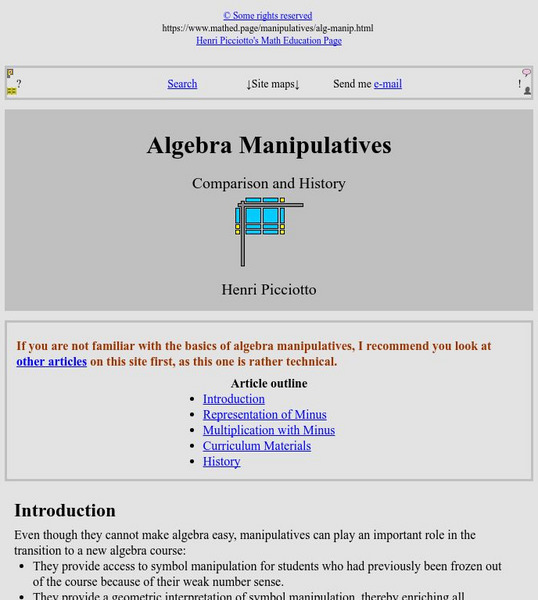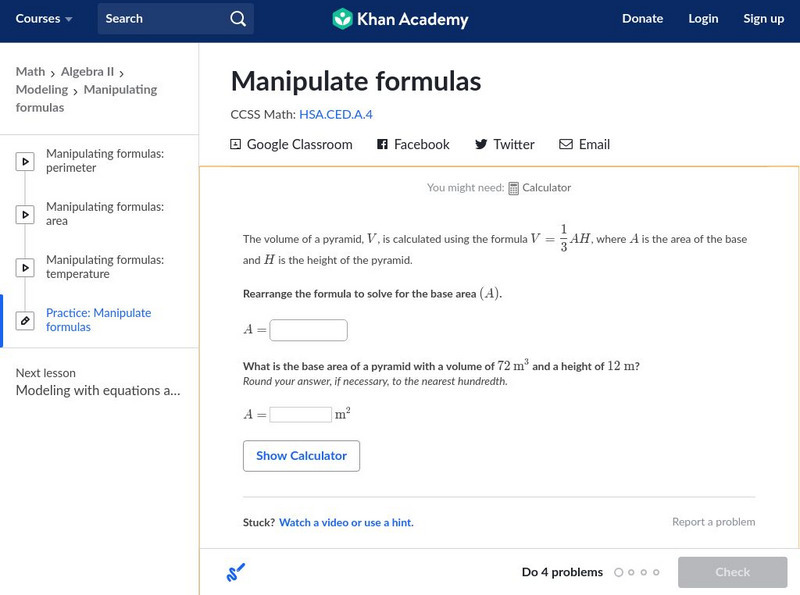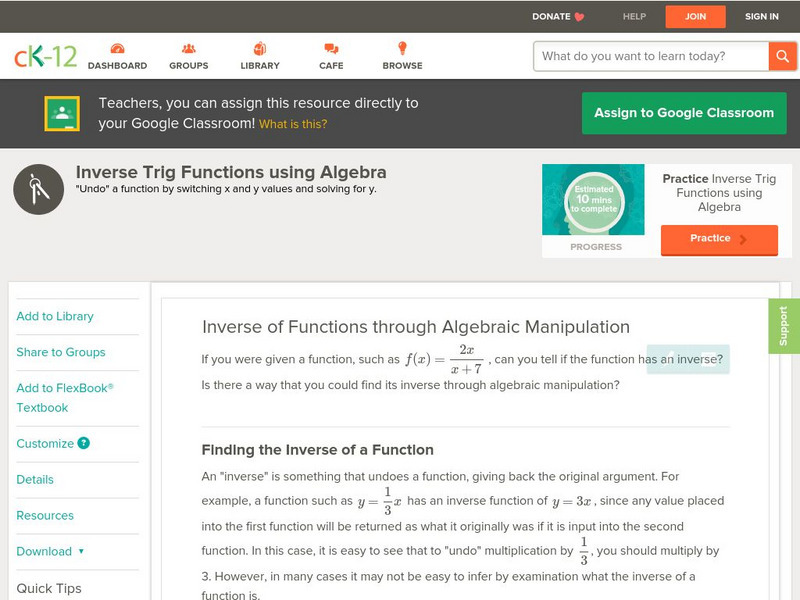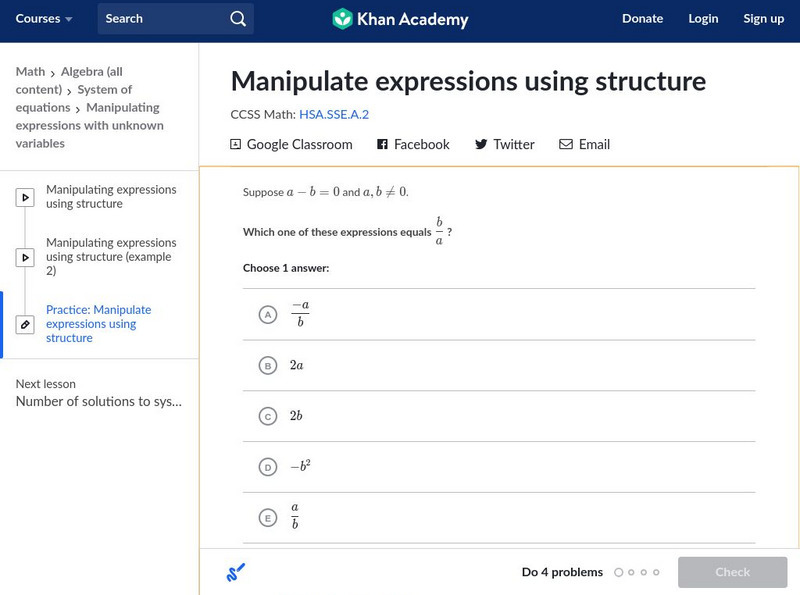Curated OER
Grade 2: Texas Problem Solving
Second graders use numerical data about Texas to write and solve real-life problems involving addition and subtraction (or multiplication and division). They work in pairs to choose three numerical facts about Texas to use to make up...
Curated OER
Impossible Graphs
Students distinguish between possible and impossible graphs of functions, and to learn why some graphs are impossible. They have practiced plotting functions on the Cartesian coordinate plane
Curated OER
Bead It!
Fourth graders use colored beads in two problems and explore the use of proportional reasoning as a problem solving method. Working Students, in groups, explain their reasoning strategies orally, and through drawings.
Curated OER
Properties of Fractals
Students build a working definition of regular fractal, look carefully at the concepts of dimension and scale, and are introduced to logarithms. They solve simple exponential equations for the exponent both by trial and error and using...
Curated OER
Composting
Eighth graders collect data from Bottle Biology compost columns and record using Excel spreadsheet.
Curated OER
Practicing Arithmetic
Students practice single operation arithmetic ranging from single digit addition to long division of decimals or real numbers using Graphit. They use data sets and rules to graph ordered pairs.
Curated OER
Properties of Fractals
Students build a working definition of a regular fractal, they measure the concepts of dimensions and scale, they explore the concept of a logarithm and they attempt to solve simple exponential equations for the exponent both by trial...
Curated OER
Irregular Fractals
Students explore the concept of irregular fractals. For this irregular fractals lesson, students discuss how to find fractal dimensions through teacher led discussion. Students calculate fractal dimensions of various fractals.
Curated OER
Pythagorean Theorem Investigation
Eighth graders investigate the Pythagorean Theorem and practice applying the theorem to various triangles. Finally, in the next lesson in the sequence, 8th graders create a song or a story to help them remember the Pythagorean Theorem.
Curated OER
Geometry and Symmetry
Students examine tessellations and their geometric properties. The lesson and discussions may be used to develop students' understanding of polygons and symmetry as well as their ability to analyze patterns.
Curated OER
How Many Bears in the Forest?
Third graders model the tag and recapture of bears and use proportions to estimate the population of the bears in their forest. This is a statistical sampling method used by scientists and naturalists to determine population numbers.
Curated OER
Taking the Temperature
Students read a thermometer in Celsius and Fahrenheit. In this thermometer reading lesson, students take the temperature in different situations and discuss the results with a partner.
Other
Mathedpage.org: Algebra Manipulatives: Comparison and History
This resource discusses the use of manipulatives in the study of Algebra. The author sees benefits in symbol manipulation to enrich understanding, in geometric interpretation strengthening the connection to other parts of mathematics,...
Texas A&M University
Wtamu Virtual Math Lab: Beginning Algebra: Adding and Subtracting Polynomials
A tutorial as an introduction to polynomials. Basic terminology and simple algebraic manipulations. Offers discussions and practice exercises with answers and explanations.
Scholastic
Scholastic: Solving the Unknown With Algebra
Young scholars will learn and reinforce skills for solving for unknowns, manipulating equations while keeping them in balance, using formulas to solve real-world challenges, and working with proportions, radicals and exponents.
Khan Academy
Khan Academy: Algebra Ii: Manipulate Formulas
Manipulate multi-variable formulas to isolate specific variables in order to solve some word problems. Students receive immediate feedback and have the opportunity to try questions repeatedly, watch a video, or receive hints.
CK-12 Foundation
Ck 12: Inverse of Functions Through Algebraic Manipulation
[Free Registration/Login may be required to access all resource tools.] Here you'll learn how to find the inverse of functions through algebraic manipulation.
E-learning for Kids
E Learning for Kids: Math: Soccer Stadium: Changing Numbers
On this interactive website students practice various math skills using a real life scenario on a soccer field. Those skills include creating numbers for a number pattern, creating patterns using manipulatives, and using diagrams to...
University of Regina (Canada)
University of Regina: Math Central: Patterning and Algebra
Large manipulatives and hands-on activities are used to teach patterns to Kindergarten and Grade One.
National Council of Teachers of Mathematics
The Math Forum: Ask Dr. Math: Compound Inequalities
"Dr. Math" provides a visual (graphical) approach to solving compound inequalities as opposed to an approach dependent upon algebraic manipulation.
Math Medics
S.o.s. Math: Simple Fractions
This S.O.S. tutorial gives students a basic review of simple fractions. Follow the tutorial to refresh your skills involving simple fraction manipulations. Each section contains problems with links to the answers.
Other
Math Ed Page: A Proposal for Early Math Education
A chapter from a book on mathematics instruction for elementary students. Henri Picciotti explains why instruction in number sense, function sense, and symbol sense is important. He offers sample plans for operation sense.
Khan Academy
Khan Academy: Equivalent Expressions
Practice determining whether or not two algebraic expressions are equivalent by manipulating the expressions. These problems require you to combine like terms and apply the distributive property. Students receive immediate feedback and...
Khan Academy
Khan Academy: Manipulate Expressions Using Structure
Rewrite an expression containing two unknown variables by choosing a given equation that is equivalent. Students receive immediate feedback and have the opportunity to try questions repeatedly, watch a video, or receive hints.























